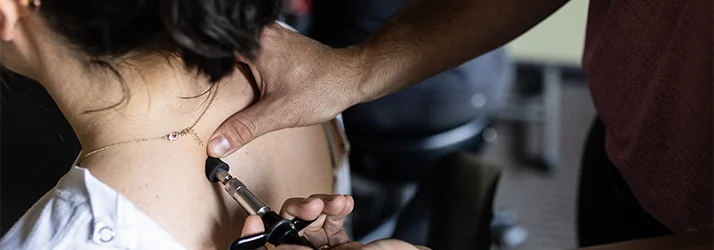Neck Pain Relief in Reno NV

Here at Luxiam Chiropractic neck pain is one of the most common ailments we treat. It’s no wonder because your neck supports all the weight of your 10-12 pound head and the neck is where most of our rotation motion occurs in the spine.
Neck pain in Reno NV often begins as an acute injury. Maybe you twisted awkwardly or slept wrong and the pain goes away in a couple of days. However, 30% of neck pain issues usually develop into something more chronic, meaning they last longer. Women are even 1.5 times more likely to suffer from neck pain.
Our lifestyles are huge contributors to our pains in the neck. If you have awkward sleeping positions or poor posture, your chances of developing neck pain is pretty high.
How We Relieve Neck Pain in Reno NV
The neck, also called the cervical spine, begins at the base of the skull and contains seven small vertebrae. While the cervical spine can move your head in nearly every direction, this flexibility makes the neck very susceptible to pain and injury. Luxiam Chiropractic is a results-driven office. We use functional measures to assess your current state and design custom care plans to support your body's ability to heal naturally. The first visit in our office is approximately 60 minutes long and will consist of a consultation with the doctor, a full spinal analysis, functional movement screening, bio-structural examination and digital x-rays all designed to get to the root cause of your neck pain.
Following the initial exam, you will return to the office for a second visit with the doctor. They will explain to you their exam findings and discuss what the best recommendations are for you to help support your health goals. After answering any questions or concerns you may have, you will receive your first specific chiropractic adjustment.
n the past 10 years, the most common cause of neck pain that we see is from…wait for it…electronic devices. People look down at their phones, ipads, and laptops for hours every day. This increases the stress on the neck, leading to neck pain and the wearing down of joints over time. We call this tech neck and have seen an increasing number of kids & teens coming into our office with neck pain, headaches and back pain from tech neck.
Even when doing your best to avoid neck pain, our bodies can still get stressed and/or injured, so it is great to know that Chiropractic adjustments are one of the safest and most effective options to relieve neck pain and get you back to living life normally!
In 2007, SPINE, one of the world's most respected research journals, looked at data from over 50,000 Chiropractic adjustments given to nearly 20,000 patients, and they found Chiropractic care to be incredibly safe and effective. Believe it or not, many people are nervous to start Chiropractic care. The truth is that Chiropractic care is safer than many medications and has far less risk than surgery.
Digital X-rays
One of the most important elements of chiropractic care is diagnostics. Chiropractic radiology is a tool utilized in care as a diagnostic practice to see exactly what is going on with your spine and determine if misalignments are present. Assess the curve in your cervical spine, posture of spine, disc space and health of the joints. The information acquired through X-ray helps the chiropractor fully understand what is occurring in the patient’s musculoskeletal system, and how a given treatment intervention could bring about positive results in each patient.
We take specific x-rays in order to determine the most effective way to adjust your neck. The assessment of your images helps the doctor determine the appropriate adjustment to help restore function to your neck. X-rays allow your chiropractor to avoid any guessing as to how to correct your subluxation. All x-rays are developed digitally to eliminate the use of film and chemicals in the office. We will go over your X-ray study together so that you understand exactly what is going on with your body before being adjusted.
Specific Chiropractic Care
The nervous system helps coordinate all systems in your body. But this information needs a way to get in and out. Nerves provide a pathway for this information to travel, and the spinal cord is made up of bundles of these nerves that extend down from the brain. Misalignments to the spine can put stress into the muscles and ligaments which can result in inflammation and altered function, known as vertebral subluxation.
At Luxiam Chiropractic we focus on the health and function of the spine. We address vertebral subluxation through our detailed assessments and apply specific chiropractic adjustments to support your body's natural ability to heal.
Custom Therapeutic Exercise Plan
Following a series of adjustments to restore alignment to your body, we recommend specific exercises to support the healing of your muscles and ligaments. Muscle weakness or imbalances can cause the body to fall out of alignment. We look to correct and restore optimal function in your body through corrective adjustments and specific exercise protocols to support your body. Stretching and strengthening are key components to correcting your problems and setting you up for long-term success.
Our office prepares a customized plan for you through our Webexercise program which includes movement recommendations based on your functional assessment. We go over the findings and recommendations with you in the office and provide you with a plan at home so that you can avoid aggravating the problem and help you get closer to achieving your health goals.
1. Upper Trapezius Stretch:
- Start standing or sitting tall, and place one hand on your lower back, the other hand on the opposite side of your head.
- Pull your head toward your shoulder, looking straight ahead, until you feel a stretch in your neck.
- Hold for at least 30 seconds (or 5-8 deep, diaphragmatic breaths) and then repeat on the other side.
The Benefits This stretch hits your upper trapezius. Because of the arm tucked behind your back and your other hand pulling your head, you get a more targeted stretch
2. Sternocleidomastoid Stretch:
- Rotate your head as far to the left as possible.From there, tilt your head back reaching toward your shoulder.
- Tilt your head until you feel a gentle stretch in the long muscle on the side of the neck, your sternocleidomastoid muscle.
- Hold for up to 30 seconds, and repeat on each side.
The Benefits: Stretching the sternocleidomastoid (SCM) muscle helps relieve neck tightness because this particular muscle plays a role in nearly all neck movement. Plus, the SCM keeps your head balanced upright. This is important for maintaining good posture and preventing neck tightness.
3. Chin Tucks: Another result of poor posture is the weakening of deep neck muscles, which can also contribute to neck pain. When the head is consistently resting in a forward position, the muscles that hold the head up can become lengthened and weak. Chin tucks are an excellent, easy exercise to improve the strength of neck muscles and decrease neck pain.
- Sit tall and pretend that you have a string coming out from the top of your head that is pulling your spine upwards with your shoulders back and head up, facing forward. Now you’re ready to do some exercises and stretches.
- Place your finger on your chin and pull your head straight back as if you are trying to push your chin into your neck / to the back of your head.
- Repeat this motion ten times and perform three sets
Common Causes of Neck Pain
1. Subluxation: Chiropractors specialize in the detection and correction of subluxations. When a joint is misaligned, it puts extra stress and pressure into the muscles and ligaments. The stress into the soft tissues creates an irritation or process of inflammation that can result in pressure into the surrounding nerves. This series of findings is known as a subluxation complex. The vertebral subluxation complex causes dysfunction in the spine and can result in pressure on the nerves as they exit the spine. Specific Chiropractic adjustments correct subluxation by restoring movement to the body and decreasing the stress points in the surrounding soft tissues.
2. Degenerative Disc Disease: Degenerative Disc Disease (DDD) is an age and trauma related condition when discs break down. Obesity, smoking and work that is hard on the spine can all contribute to the onset of Degenerative Disc Disease. When the disc height reduces the space for the nerves to exit the spine gets smaller, this is known as spinal stenosis. Degenerative Disc Disease can not be reversed but can be slowed if caught soon enough. Our office utilizes x-ray imaging to assess the health and condition of your spine as well as the most specific adjustments possible to restore movement and function to your body.
3. Muscle Strain: When the body is not moving evenly and distributing weight the way it is designed muscles and ligaments can become strained. Muscle strains can be caused by sudden activity or over time with repetitive motion, poor posture or weak neck muscles. Many times, muscle strains are able to resolve on their own but you want to fix it early so that scar tissue does not build up.
4. Tech Neck: One of the most common conditions that we treat in our office is Tech Neck. This is caused by looking down at our devices or using poor posture at desks. Forward head posture and increased stress of the head weight will often cause dull, achy discomfort that intensifies with movement, or pain localized in the neck. The curve in the cervical spine is one of the most affected structural components to Tech Neck. When we lose the curve of our neck, we reduce structural stability as well decrease our neurological adaptive processing.
Tech neck can cause facet joint dysfunction which involves joints of the vertebrae that become inflamed and result in pain and altered movement. Cartilage inside the facet joint can break down and this is what is actually inflamed. Extension and standing for long periods of time can aggravate the facet joints as they are supporting the weight of the body.
5. Whiplash: Whiplash injuries are commonly caused by car accidents but can also occur during sporting events. The traumatic event of whiplash can cause a straightening of the cervical spine and if it is not addressed can lead to long term, chronic issues such as numbness, tingling or weakness. Following a whiplash injury, some people experience issues beyond just pain such as blurred vision, difficulty sleeping or even memory problems. It is important to have your body evaluated by a professional following any whiplash injury.
Frequently Asked Questions
When should you see a chiropractor for neck pain?
If a pain persists longer than usual it should be considered serious and evaluated by a chiropractor. When the body is balanced and free of skeletal or muscular disturbances it should be able to recover without the use of drugs or surgery.
Is it okay to pop my own neck?
How can I relieve my neck pain?
Why does my neck hurt on one side?
How can you tell if your neck is out of alignment?
Monday
7:00am - 6:00pm
Tuesday
7:00am - 6:00pm
Wednesday
7:00am - 6:00pm
Thursday
7:00am - 6:00pm
Friday
7:00am - 5:00pm
Saturday
8:30am - 1:00pm
Sunday
Closed
Luxiam Chiropractic
6815 Sierra Center Pkwy Suite 250
Reno, NV 89511



